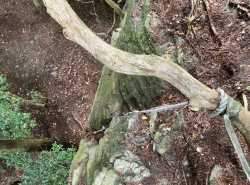Quoted By:
Sheer drops often call for rapelling, scree, gravel, shale, loose slopes often call for scrambling which you can assist with a simple rope with knots in it. If the slope is complex, full of plants, well you might consider climbing.
But again, generally you will just refuse to scale the slope, and walk around. Not worth the time you'd spend descending properly, not worth the time you'd spend walking around. Everything about the picture you posted screams "not worth".
There are a few simple techniques you can use to assist a decent, the first is simply roping up the top meter so you aren't going to fall straight off the ledge at the top. To lower yourself into a hanging position. A straight rope with knots is safer because you're unlikely to get tangled/hung on it. If you've got a sheer drop of three meters, you can rope the first meter. Then you're basically standing on the ground at the bottom. The risk in that slop would primarily be falling from the top of it, if you lost your grip on the rope and fell from halfway you'd probably be falling a metre onto your feet. Not good, but your unlikely to die.
If you had a steep shale slope, a gully, gravel, well you might rapell it and scramble with your feet. You couldn't "fall" the entire distance top to bottom, so the risk would be rolling and breaking an arm, landing on your head. So rapelling keeps you oriented correctly where you may have no proper footing.
If the drop is full of trees, things you could get injured by or caught on, well maybe ropes are just a liability and you're better off free climbing. You might find a place with multiple hand and foot holds.
So the slope you posted calls for a rope climb, but i can almost guarantee you that it's probably the stipudest place to descend. Sheer faces like that don't tend to extend very far. Just because someone else did it for the challenge, you'd be mentally challenged to copy them.
And fuck that dead branch.

